Raising the Migration - Part II
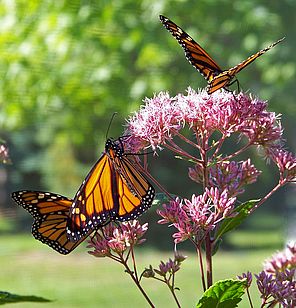
Editor’s note: This article is a continuation of the fall 2018 article on raising Monarch butterflies for the fall migration. Both articles were written by Laura Pratt, LCC’s current ECO AmeriCorps Education & Outreach Coordinator, who raised monarchs in her home last year. Laura’s service year with LCC began in mid-September and runs through early August 2019. She’s assisting us with a host of educational programs, as well as writing about natural history and lake issues. Monarch butterflies are important pollinators in the Lake Champlain watershed. They rely on milkweed during their caterpillar stage – a plant which is growing scarce with an increase in urbanization and pesticide use. However, you can make a difference by planting native varieties of milkweed in your garden, encouraging your town to replace lawn with pollinator gardens where possible, and even by raising monarch butterflies yourself!
So you’re interested in raising a butterfly. Perhaps you’re worried about declining pollinators, and want to give their population a boost. You might be hoping this will be a fun summer hobby (it is!). Or maybe you’re like me and had to remove milkweed from a garden, found some eggs on it, and felt like a monster.
Raising monarchs is like raising any living creature – fun, rewarding, and unpredictable. The caterpillars will go through more milkweed leaves than you think they’re capable of. At least one will escape its terrarium in search of the perfect place to metamorphosize (check your houseplants). You will likely find yourself googling if a chrysalis is supposed to look like that. It’s up to you how much responsibility you take on – if you’re interested in planting monarch habitat, raising just one caterpillar, or establishing a full-scale butterfly nursery.
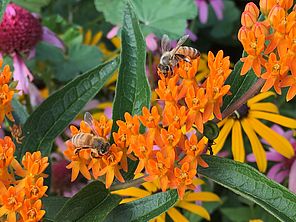
The first step, no matter which course of action you choose, is to plant some milkweed on your property. Milkweed is the only larval host plant of monarch butterflies, which means it’s the only plant they will lay their eggs on, and the only leaf monarch caterpillars can eat. There are many different varieties of milkweed, so it’s important to choose a variety that’s native to your region. Non-native milkweed, particularly tropical milkweed, is believed to disrupt the monarch’s life cycle because it continues growing after the native milkweed has died back. This can cause the monarchs to linger in the north when they should be migrating south. If you do decide to keep your tropical milkweed, you should consider cutting it back in the fall (around mid-September) to both simulate dormancy and prevent the spread of seeds. Click here for more tips on planting milkweed and starting your butterfly garden!
In order to support the adult butterflies laying the eggs, as well as other pollinators in your garden, it’s a good idea to plant milkweed near nectar-rich flowers, like those outlined by the Xerxes Society’s pollinator guide. You can find native plants via online plant swaps or at native plant nurseries.
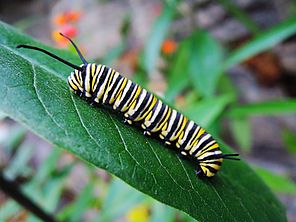
When you have your garden established you can start to look for the tiny white monarch eggs on the underside of milkweed leaves. They are roughly the size of a dandelion seed, and might be difficult to distinguish from drops of milkweed sap. When you find an egg you’ll want to pick the whole leaf it’s on and take it indoors to hatch, keeping the stem wrapped in damp cloth or a small vase so it doesn’t wither. Although they are too bitter for most predators to eat more than once, monarch caterpillars are still a tempting target. It’s much easier to collect them while they’re still in their eggs.
If you too decide to raise monarchs, please remember to use only the eggs you find in the wild. Companies that ship eggs and caterpillars for you to raise sometimes draw on infected populations, which spreads parasites further, and breeding in captivity has been shown to reduce monarchs' inclination to migrate.
When the caterpillars are newly hatched I could usually trust them to stay on their leaves, but it never hurts to be careful. To my dismay I found that larger caterpillars are especially prone to wandering off, perhaps feeling a sense of teenage independence. After my fourth encounter with a stripy, crayon-sized bug inching tirelessly up the wall I decided I needed a containment strategy. A glass terrarium with a screen top, like one used for reptiles, worked perfectly. The caterpillars stayed put, were well-ventilated, and the older ones loved to use the screen top for chrysalis formation.
Much like human toddlers, caterpillars are drawn to the closest source of danger. Unfortunately that danger can often come from each other, so here is a quick tip to preventing accidental caterpillar cannibalism: keep the generations separated. Tiny caterpillars should be kept away from medium-sized caterpillars, and the big ones should be in another enclosure entirely. Most caterpillars are so single-minded in their need to eat that they don’t notice if there’s something extra on the leaf they’re eating. It never happened to me, but I was very proactive. There are some things I don’t need on my conscience.
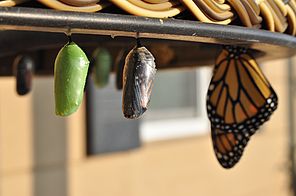
Monarch caterpillars grow up fast. It only takes them ten to fourteen days to grow from the size of a dandelion petal to that of a baby carrot. In that time they eat a lot of leaves and poop a lot of pellets, so be sure to keep them well-fed and well-cleaned. When they reach the end of their caterpillar childhood they will begin to distance themselves, they will start looking for a place to become a chrysalis.
The process of becoming a chrysalis is a fascinating one. When the monarch has found the perfect spot it will begin to spin a silk pad to hang from. From my research I learned if you find it at that stage you must never disturb it, even if it’s in an inconvenient place. The silk-spinning process cannot be restarted. The caterpillar will attach its back end to the silk pad and hang down like a “J”, seeming to contemplate its new perspective on the world. The first time I found my caterpillar hanging down, ready to transform, I spent hours sitting by the terrarium waiting to see its next step – but it isn’t so easy to catch. Although I reluctantly went to bed around midnight, sure that I would miss the transformation, the caterpillar was still there when I woke up in the morning.
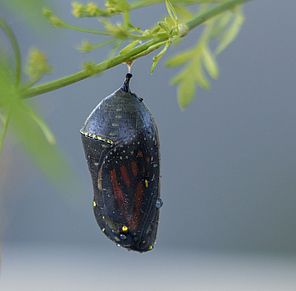
However, I saw that it had a greenish tinge, and the curled end of its body swelled slightly. Things were looking hopeful. I pulled up a chair again and sat down with a book. Over an hour had passed before I saw movement in the corner of my eye – the caterpillar had begun to wiggle. It twisted and turned on the end of its silk pad, its movements growing steadily more frantic until, like the Hulk bursting out of his shirt, the striped skin of the caterpillar molted off. As the skin molted the green chrysalis beneath was revealed, still wriggling as it condensed and hardened. It was very cool -- and slightly horrifying.
Within the day the still bug-like chrysalis had hardened into an elegant green capsule flecked with gold. My monarch spent another ten to fourteen days inside its chrysalis, and in the final days I saw the chrysalis change from emerald green to the black-and-orange stained glass of butterfly wings.
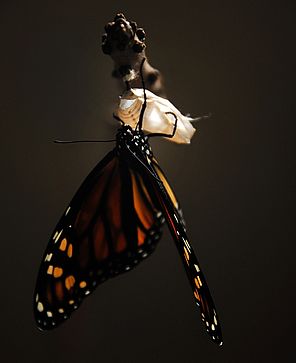
I was lucky enough to be there again when the butterfly emerged. It slowly cracked open its chrysalis, like a chick struggling to emerge from its egg, then spilled out all at once as the chrysalis split open. Its wings were tiny and its abdomen huge. I read later that this is normal – the butterfly stores most of its bodily fluid in its abdomen, and then pumps it into the wings after it emerges. After a few minutes the wings had expanded, and the butterfly slowly opened and closed them as they dried. With a few hours rest my monarch butterfly was more than ready to leave the nest. No longer clinging to the chrysalis she fluttered blindly against the sides of her enclosure, then zipped away rather unceremoniously as soon as I opened the top in my backyard.
When you have released your own monarch back into your pollinator garden you can admire a job well done. As you do you might consider adding more plants to it. After all, you like swallowtail butterflies too, right? And bumblebees are pretty darn cute.
